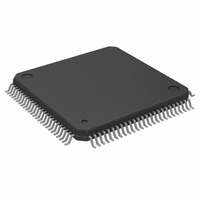SLXT914QC.B3 Intel, SLXT914QC.B3 Datasheet - Page 10

SLXT914QC.B3
Manufacturer Part Number
SLXT914QC.B3
Description
IC QUAD ETHERNET REPEATER 100QFP
Manufacturer
Intel
Type
Repeaterr
Datasheet
1.NLXT914PC.B3.pdf
(45 pages)
Specifications of SLXT914QC.B3
Rohs Status
RoHS non-compliant
Tx/rx Type
Ethernet
Voltage - Supply
4.75 V ~ 5.25 V
Current - Supply
180mA
Mounting Type
Surface Mount
Package / Case
100-QFP
Delay Time
-
Capacitance - Input
-
Other names
831521
Available stocks
Company
Part Number
Manufacturer
Quantity
Price
Intel
Table 2.
Table 3.
31-Oct-2005
10
®
LXT914 Flexible Quad Ethernet Repeater
Inter-Repeater Backplane Signal Descriptions
Mode Select and Control Signal Descriptions
NOTES:
PLCC
PLCC
1. IRENA and IRDAT can be buffered between boards in multi-board configurations. Where buffering is used,
2. IRCFS and IRCOL cannot be buffered. In multi-board configurations, the total impedance on IRCOL should
12
13
28
17
35
—
4
5
6
7
8
a 330 Ω pull-up resistor can be used on each signal, on each board. Where no buffering is used, the total
impedance should be no less than 330 Ω.
be no smaller than 330 Ω. IRCFS should be pulled up only once, by a single 330 Ω, 1% resistor.
PQFP
PQFP
94
95
96
97
98
33
30
14
40
8
9
LOC/EXT
Symbol
Symbol
A/SYNC
LEDJM/
AUISEL
AUISEL
LEDM0
LEDM1
IRENA
IRDEN
IRCOL
IRCFS
IRDAT
Intel
®
Order Number: 248989, Revision: 003
LXT914 Flexible Quad Ethernet Repeater
I/O
I/O
I/O
I/O
I/O
I/O
I/O
I/O
I/O
O
I
I
I
Inter-Repeater Backplane Enable. This pin allows individual LXT914
repeaters to take control of the Inter-Repeater Backplane (IRB) data bus
(IRDAT). The IRENA bus must be pulled up locally by a 330 Ω resistor.
IRB Data. This pin is used to pass data between multiple repeaters on the
IRB. The IRDAT bus must be pulled up locally by a 330 Ω resistor.
IRB Driver Enable. The IRDEN pin is used to enable external bus drivers
which may be required in synchronous systems with large backplanes. This
is an active Low signal, maintained for the duration of the data
transmission. IRDEN must be pulled up locally by a 330 Ω resistor.
IRB Collision Flag Sense (IRCFS) and IRB Collision (IRCOL). These two
pins are used for collision signalling between multiple LXT914 devices on
the Inter-Repeater Backplane (IRB). Both the IRCFS bus and the IRCOL
bus must be pulled up globally with 330 Ω resistors. (IRCFS requires a
precision resistor [±1%].)
Backplane Sync Mode Select. This pin selects the backplane sync mode.
When this pin is left floating an internal pull-up defaults to the
Asynchronous mode (A/SYNC High). In the asynchronous mode 12 or
more LXT914s can be connected on the backplane, and an external 10
MHz backplane clock source is not required. When the synchronous mode
is selected (A/SYNC tied Low), 32 or more LXT914s can be connected to
the backplane and an external 10 MHz backplane clock source is required.
Management Mode Select. This pin selects the management mode. When
this pin is left floating, an internal pull-up defaults to the Local management
mode (LOC/EXT High). In the Local mode, setup parameters are
downloaded from an EEPROM during initialization. Once initialized with the
setup parameters, the repeater functions independently.
LED Driver or DTE/MAU Select. At reset, this pin selects the mode of the
AUI port. If left floating, an internal pull-down device forces the AUI port to
DTE mode. If pulled High with an external resistor, the port changes to a
MAU, in which case the functions of the LEDJM pin are disabled and the
default LED mode (Refer to
DTE/MAU Select. This pin changes the mode of the AUI port independent
of the condition at reset. This function is available only in the 100-pin PQFP
package.
LED Mode 0 & 1 Select. These two pins select one of four possible LED
modes of operation. The Functional Description section describes the four
modes.
2
Table
Description
Description
7) is not available.
Datasheet
1
1












